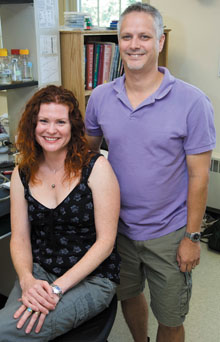  |
| HOME | THIS ISSUE | CALENDAR | GRANTS | BACK ISSUES | < BACK | NEXT > |
Biologists find evidence supporting controversial genetic theoryby Cindy Weiss - September 4, 2007 | ||||
| Biologists in the College of Liberal Arts and Sciences and their collaborators at other universities have found experimental evidence that supports a controversial theory of genetic conflict in the reproduction of some animals. The research provides a rare example of Darwinism in action at both the DNA and the species levels. It supports the idea of a genetic “arms race” or “battle of the sexes” occurring at the molecular level in animals that support their developing offspring through a placenta. At stake is the fetus’s growth rate and how much that costs the mother, who supplies its nutrients. The research was described in a scientific paper that was the cover story of the July 24 issue of the scientific journal, Proceedings of the National Academy of Sciences. The editorial board has reported that the paper is one of the 20 most-read papers online during the month of July. Michael O’Neill, associate professor of molecular and cell biology, is the lead author. Rachel O’Neill, associate professor of molecular and cell biology, faculty from other institutions, and graduate students and a postdoctoral fellow from UConn and elsewhere are co-authors. The O’Neills, who are married, are active researchers at UConn who often hold joint meetings of their research groups and collaborate on projects. The paper was edited by Shirley Tilghman, president of Princeton University and a molecular biologist with a particular interest in this area of study. She was Michael O’Neill’s postdoctoral adviser. Part of the significance of the research is in providing experimental proof of a theory offered in the 1990s by Harvard University biologist David Haig and others. It holds that in animals with a placenta, genetic material from the father and the mother promote different growth rates in the embryo, which produces a conflict over nutrients. In most animals, the male provides his genetic material for the offspring and leaves. The mother has a more intimate relationship with the fetus, nurturing it through her placenta and, in some animals, nursing and caring for the baby after it is born. But while the father may not be present, the genetic material he provided is hard-wired to provide fast fetal growth, so that his offspring will be the hardiest, best survivors, the ones who demand the most of the mother’s placental nutrients. The mother, on the other hand, provides genetic material that promotes the same growth level for all of her offspring, so that her nutrients will be available to support her and the offspring from all her matings. So the initial skirmish in the battle of the sexes could be said to take place at the embryonic level. Whose genetic material will prevail in the offspring, and which offspring will prevail in the survival of the species? Evidence to support the “parent-offspring conflict theory” has been found in placental mammals. But the O’Neills’ study is the first to look for this conflict in any of the many species other than mammals that have evolved placental reproduction. The UConn scientists and their collaborators studied a family of live-bearing fish that includes the popular aquarium species of mollies and guppies. Most fish are egg-layers, but some species in this family have evolved a placenta-like structure and give live birth.
The O’Neills have maintained for their research a colony of desert top minnows at UConn, the Poeciliopsis Genetic Stock Center, which was established here 30 years ago by another collaborating couple in biology, Jack Schultz and his wife, Mary, both now retired. The new research tested the conflict theory by studying samples of the IGF2 growth hormone (insulin growth factor 2) collected from 50 species of minnows. The IGF2 gene is found in all vertebrates, including fish and people. It is the primary fetal development growth hormone. The IGF2 gene sequences looked different in some species of the minnows, showing that segments of the gene had evolved. It appeared the biggest changes were in those species of minnows that had developed placentas. Some species of the minnows are egg-laying, and some evolved placentas. The question for the researchers was, did the changes they saw in the IGF2 gene sequence exactly correlate with the evolution of the placenta? Was there a cause and effect, or was the change just random? The researchers found that the change they saw supported the Darwinian theory of natural selection, providing independent support for the theory of conflict between the male and female genetic material in producing offspring. The genomes of placental animals are fundamentally affected by being placental, and it is the imbalance of parental investment in the offspring, or the battle of the sexes at the molecular level, that changes the genome, the researchers found. “It’s very rare to find good examples of Darwinian selection,” says Rachel O’Neill, “but we can definitely say it is placental, and that has led to Darwinian selection.” Michael O’Neill likens the pattern of evolutionary change they saw to the “genetics arms race” that also takes place when bacteria develop resistance to an antibiotic, and new antibiotics are developed to counter it. About 50 species of minnows were used in the new study. Besides the UConn minnows, research specimens were provided by co-authors from the University of California-Riverside, Texas A&M University, and the University of Puerto Rico-Rio Piedras. Detailed statistical analysis of the findings was done by Dawn Carone and Gianni Ferreri, Ph.D. students advised by Rachel O’Neill, using a large array of parallel computers in UConn’s Biotechnology Center. The computer power made it possible to analyze data in hours rather than days, notes Michael O’Neill. The research project was funded in part by the National Science Foundation, with additional funding from the College of Liberal Arts and Sciences and the University of Connecticut Research Foundation. |
| ADVANCE HOME UCONN HOME |

